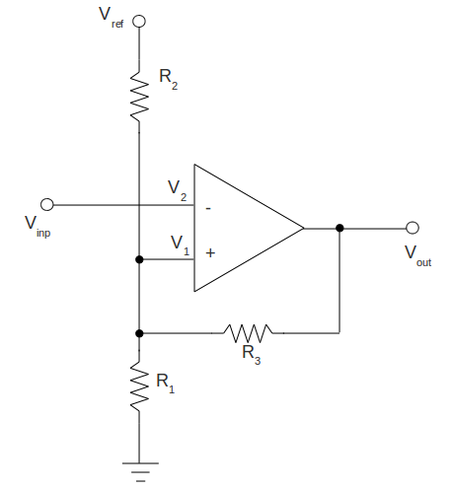Difference between revisions of "GradFinalLab RS"
Jump to navigation
Jump to search
| Line 22: | Line 22: | ||
==Identify the input voltage threshold levels at which a <math> V_{in}</math> will produce <math>V_{out} \approx V_{cc}</math>== | ==Identify the input voltage threshold levels at which a <math> V_{in}</math> will produce <math>V_{out} \approx V_{cc}</math>== | ||
| − | + | 1) if the output is high: | |
| − | <math> | + | <math>V_2 = \frac{R_{123}}{R_2}V_{ref} + \frac{R_{123}}{R_3}V_{cc}</math> |
| − | + | 2) if the output is low: | |
| − | + | <math>V_2^' = \frac{R_{123}}{R_2}V_{ref} - \frac{R_{123}}{R_3}V_{cc}</math> | |
| + | |||
| + | where | ||
| − | <math> | + | <math>R_{123} = (R_1 || R_2 || R_3) = \frac{R_1 R_2 R_3}{R_1+R_2+R_3}</math> |
| − | |||
| − | |||
| + | By substituting the actual values: | ||
| − | + | <math>V_2 = \frac{R_{123}}{R_2}V_{ref} + \frac{R_{123}}{R_3}V_{cc}</math> | |
| − | <math>V_2 | + | <math>V_2^' = \frac{R_{123}}{R_2}V_{ref} - \frac{R_{123}}{R_3}V_{cc}</math> |
| − | + | and doing math and handling the error propagation: | |
==Compare the threshold values to what is expected.== | ==Compare the threshold values to what is expected.== | ||
Revision as of 15:08, 26 April 2011
Construct a Schmitt Trigger using the 741 Op Amp
Draw the Schmitt Trigger circuit you constructed. Identify the values of all components
To construct the circuit above I am going to use the following components and voltages:
Graph as a function of . Is there a hysteresis loop?
Identify the input voltage threshold levels at which a will produce
1) if the output is high:
2) if the output is low:
where
By substituting the actual values:
and doing math and handling the error propagation:
Compare the threshold values to what is expected.
Go Back to All Lab Reports Forest_Electronic_Instrumentation_and_Measurement
